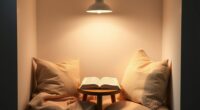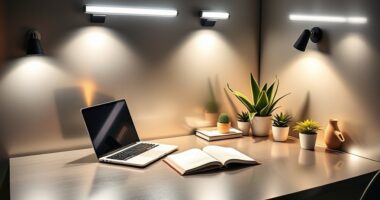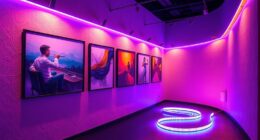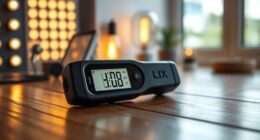If you’re looking for the best DIY spectroscope kits for classrooms, I suggest options like the Eisco Economy and Premium models, which are affordable, durable, and offer accurate spectral analysis. Kids can build kaleidoscopes with the kit by Kbraveo or experiment with handheld devices for emission spectra. These kits promote hands-on learning and make science exciting and accessible. Keep exploring to discover how to choose the perfect kit for your educational needs.
Key Takeaways
- Budget-friendly kits like Eisco Economy Spectroscopes are ideal for classroom group activities and introductory spectral analysis.
- Mid-range options such as the EISCO Premium Quantitative Spectroscope offer precise measurements for advanced science lessons.
- Children’s DIY kaleidoscope kits promote hands-on learning, creativity, and understanding of light reflection in a fun way.
- Portable, lightweight designs with durable materials ensure easy handling and engaging science experiments outside the lab.
- Many kits include colorful accessories and clear instructions, making science both accessible and exciting for students of all ages.
EISCO Economy Spectroscope Tube Pack of 6
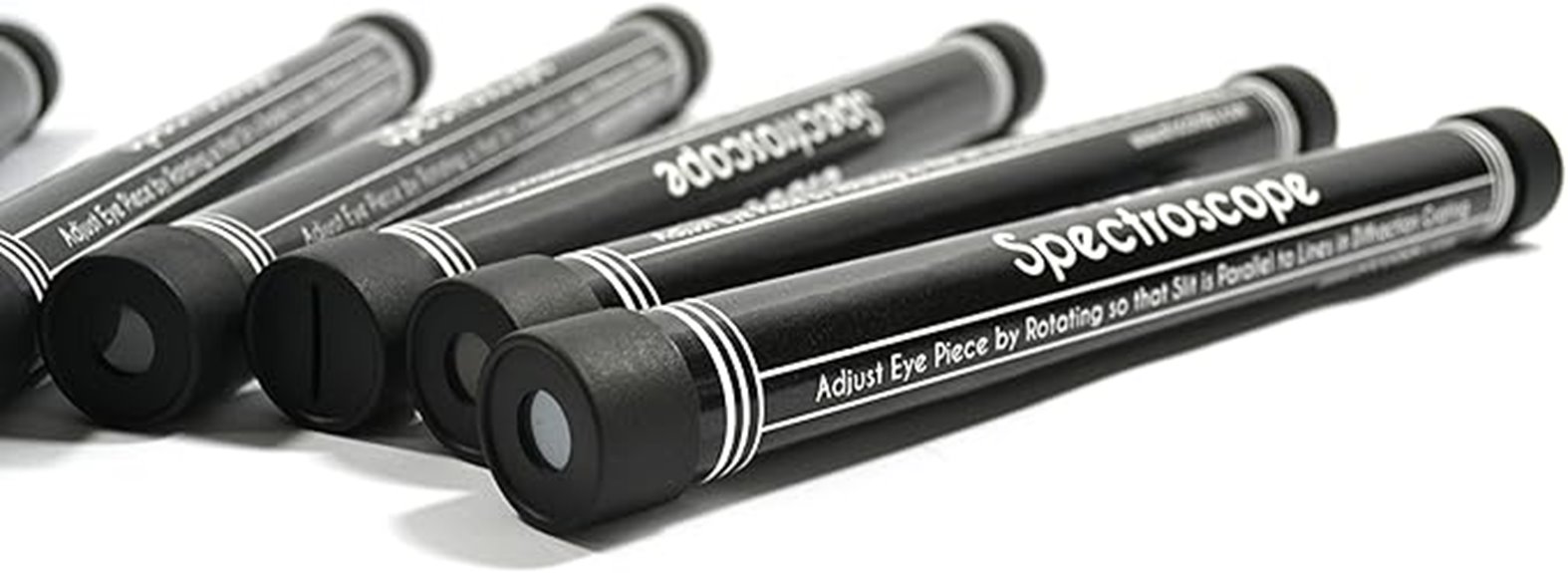
If you’re looking for an affordable and easy-to-use spectroscope for classroom experiments, the EISCO Economy Spectroscope Tube Pack of 6 is an excellent choice. Each tube measures just over 10 inches and weighs only 1.6 ounces, making them lightweight and portable. The pack includes six units, perfect for group activities or multiple demonstrations. These spectroscopes feature removable end caps and built-in diffraction gratings, allowing students to analyze light spectra directly. The adjustable slit helps control diffraction patterns for detailed study. Overall, they’re simple, effective tools that introduce core optics concepts, making learning about light and spectra engaging and accessible.
Best For: educators and students at various levels seeking an affordable, straightforward tool to explore light spectra and diffraction in classroom settings.
Pros:
- Cost-effective and easy to use for beginners and students
- Lightweight, portable, and suitable for group activities
- Includes removable end caps and built-in diffraction gratings for hands-on spectral analysis
Cons:
- Some units may arrive with missing or damaged parts, affecting usability
- Basic construction may limit durability for frequent classroom use
- Adjustments like slit calibration may require careful handling for optimal results
Eisco Labs Economy Spectroscope Tube, Pack of 24

The Eisco Labs Economy Spectroscope Tube, Pack of 24, is an excellent choice for educators and students looking to explore light spectra without breaking the bank. Each tube measures just over 10 inches long with a compact design, making them easy to handle during experiments. They enable quick identification of light wavelengths and feature an adjustable slit cap to produce diffraction patterns, enhancing understanding of light behavior. Perfect for classroom demonstrations and student activities, these spectroscopes offer a hands-on way to learn about optics. However, some users report that the tops and bottoms can be loose, requiring gluing for added stability during use.
Best For: educators and students seeking affordable, hands-on spectroscopic tools to explore light spectra and optics in a classroom setting.
Pros:
- Affordable pack of 24 units ideal for multiple students and demonstrations
- Enables quick identification of wavelengths and visual understanding of spectra
- Features an adjustable slit cap for producing diffraction patterns, enhancing learning
Cons:
- Tops and bottoms of spectroscopes are not tightly secured and may come off easily
- May require gluing or additional reinforcement for durability during repeated use
- Slightly over 10 inches in length, which may be less compact for some storage or handling needs
EISCO Premium Quantitative Spectroscope
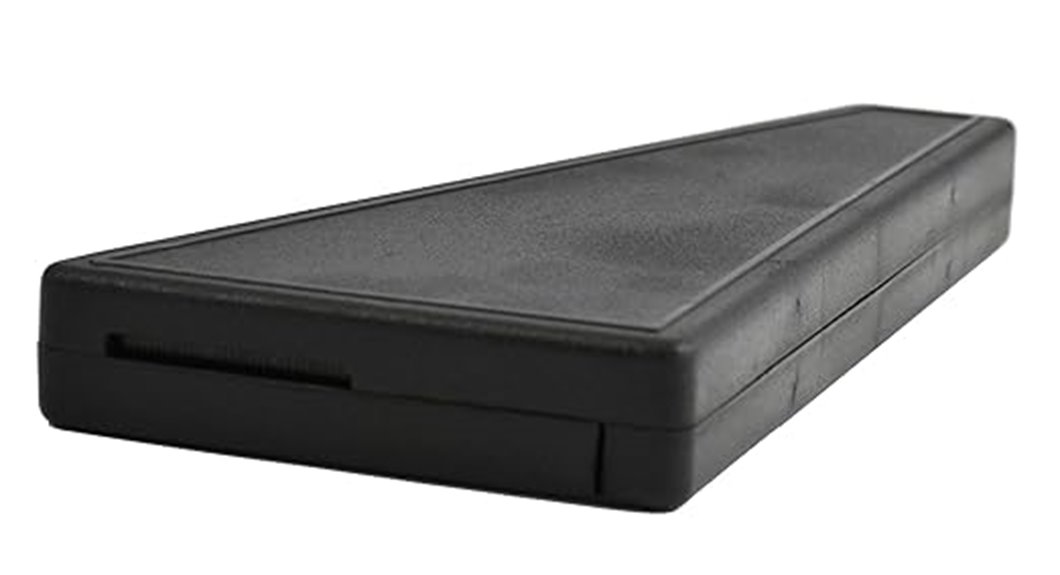
Designed for students and hobbyists seeking accurate spectral analysis, the EISCO Premium Quantitative Spectroscope stands out with its high-resolution diffraction grating and precise measurement capabilities. It covers wavelengths from 400.0 to 700.0nm, ideal for studying light sources, color spectra, and basic astronomy. The durable design securely holds the diffraction grating and scale, ensuring clear, reliable readings. With a measurement accuracy of ±5.0nm, it provides dependable results for experiments like flame tests and spectral analysis. Its premium construction enhances performance, allowing detailed observation of light sources with confidence. This spectroscope is perfect for those who want precise, versatile spectral data in a user-friendly package.
Best For: students, hobbyists, and educators seeking precise spectral analysis for experiments, light source studies, and basic astronomy.
Pros:
- High-resolution diffraction grating with 500 lines/mm for detailed spectral data
- Accurate measurement range from 400.0 to 700.0nm with ±5.0nm precision
- Durable design that securely holds components for reliable, clear readings
Cons:
- May be more expensive than basic spectroscopes for casual users
- Requires careful handling to maintain calibration and accuracy
- Limited wavelength range if studying beyond 700.0nm or below 400.0nm
Gem Spectroscope with Adjustable Focus for Gemology Testing
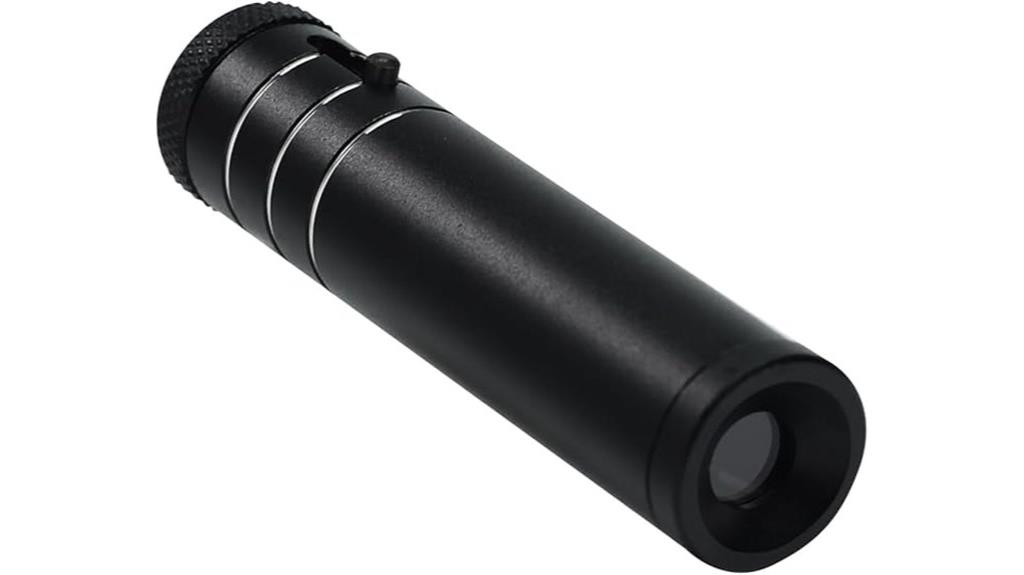
A gem spectroscope with adjustable focus is an essential tool for anyone serious about gemology testing, whether you’re a professional gemologist, student, or hobbyist. Its adjustable focus feature guarantees accurate analysis across various gem sizes, making it versatile and reliable. Crafted with high-quality optical glass and a durable powder-coated aluminum body, it offers clear readings within the 400-700nm range. Compact and lightweight, it’s perfect for fieldwork or lab use. This spectroscope helps identify gemstones, verify authenticity, and enhance educational experiences, all while providing precise, dependable results in a portable design that’s built to last.
Best For: professional gemologists, students, and hobbyists seeking precise, portable gemstone analysis tools.
Pros:
- Adjustable focus ensures accurate readings for various gem sizes.
- Made with high-quality optical glass and durable aluminum for longevity.
- Compact and lightweight design facilitates easy field and lab use.
Cons:
- Limited to a wavelength range of 400-700nm, may not detect all gemstone features.
- May require some training to achieve optimal focus and reading accuracy.
- Slightly higher price point compared to basic spectroscopes, reflecting its quality.
Handheld Spectroscope Light Emission Spectroscopy Spectrum Hobby Kit
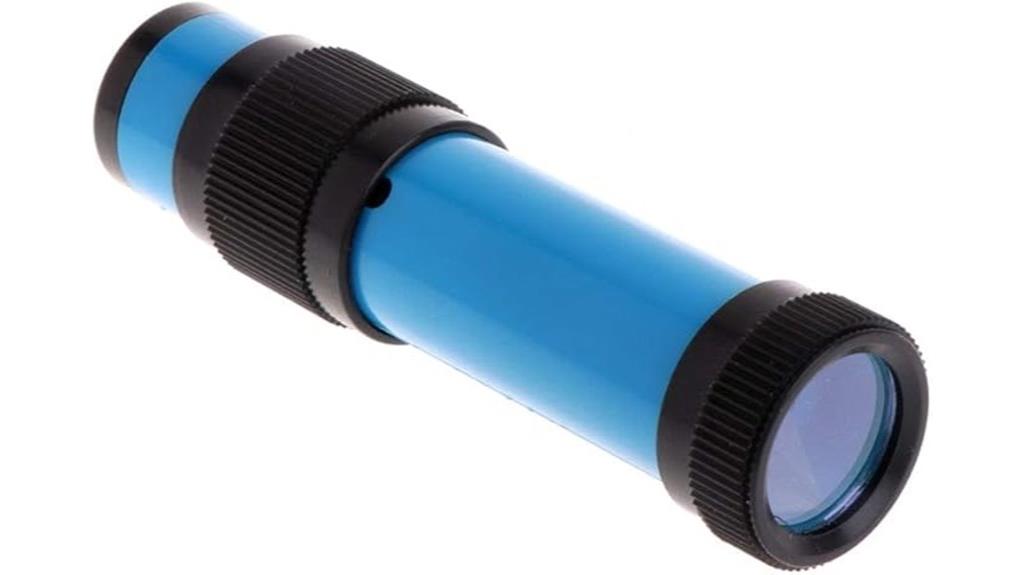
If you’re a hobbyist, student, or amateur scientist enthusiastic to explore light spectra firsthand, the Handheld Spectroscope Light Emission Spectroscopy Spectrum Hobby Kit is an excellent choice. It allows you to analyze emission spectra from various sources, including the Sun and fluorescent lights, helping you understand light composition directly. Made with optical glass, it features a prism and converging lens for high-resolution spectrum observation. Compact and lightweight, it’s easy to hold and use, making it perfect for science projects or personal experiments. Plus, it’s affordable and simple to operate, offering a hands-on way to learn about light and spectra in a fun, accessible manner.
Best For: hobbyists, students, and amateur scientists eager to explore and analyze light spectra firsthand.
Pros:
- Provides high-resolution spectrum observations with optical glass construction.
- Compact, lightweight, and easy to handle for personal or educational use.
- Affordable and simple to operate, making it accessible for beginners and students.
Cons:
- Customer reviews indicate dissatisfaction, with a 1-star rating based on limited feedback.
- Manual measurement tolerances are relatively broad at 1-3mm, which may affect precision.
- Listed with a very low product rank and limited reviews, suggesting limited popularity or recognition.
10 Sets DIY Kaleidoscope Kit for Kids
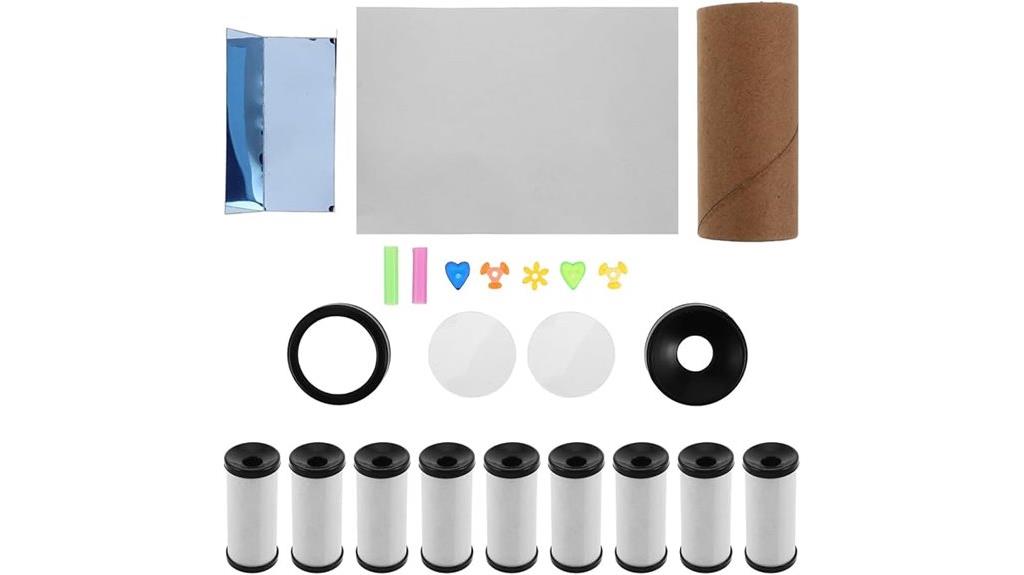
The Sets DIY Kaleidoscope Kit for Kids is an excellent choice for young children enthusiastic to explore science and creativity. Its durable paper and plastic design make it lightweight and easy to handle, perfect for small hands. At just over 2 inches long, it’s portable enough for indoor and outdoor use. The kit offers a fun, hands-on way to learn about colors, patterns, and light reflection. Plus, kids can personalize their own kaleidoscope, fostering imagination and fine motor skills. With 10 sets included, it’s ideal for group activities or multiple projects, making science fun and engaging for kids aged 15 and up.
Best For: young children aged 15 and up who are interested in exploring science, creativity, and sensory play through hands-on activities.
Pros:
- Durable and lightweight design suitable for small hands, making it easy to handle and carry.
- Includes 10 sets, ideal for group activities, classroom use, or multiple projects.
- Promotes educational development by enhancing observation skills and encouraging creative design.
Cons:
- May be too simple for older children or those seeking more advanced scientific experiments.
- Limited to basic kaleidoscope construction, which might not satisfy more experienced crafters.
- Made primarily of paper and plastic, which may wear out or get damaged with frequent use.
Hygloss Kaleidoscope Kit for Kids (12 Pack)

Looking for an engaging, educational activity designed for young children? The Hygloss Kaleidoscope Kit for Kids (12 Pack) offers a fun way to explore optical illusions and patterns. Each kit includes 12 easy-to-assemble kaleidoscopes, complete with mirrors, colorful tiles, and clear instructions. Kids can personalize their creations with stickers or drawings, boosting creativity. Once assembled, twisting or holding the kaleidoscope towards light produces mesmerizing displays of colors and shapes. The lightweight, battery-free design makes it perfect for classroom or home use. With positive reviews and simple assembly, this kit makes learning about reflections and patterns both exciting and accessible for children aged 3 and up.
Best For: young children, especially ages 3 and up, who enjoy exploring optical illusions, patterns, and engaging DIY activities at home or in the classroom.
Pros:
- Promotes creativity and artistic expression through personalized decorating options
- Easy to assemble with straightforward instructions suitable for young children
- Lightweight and portable, making it convenient for various settings without batteries needed
Cons:
- Limited to visual and educational entertainment without electronic or interactive features
- May require adult supervision for very young children during assembly
- Small parts like tiles and mirrors could pose a choking hazard if not handled carefully
EISCO Economy Spectroscope Tube – 15pk
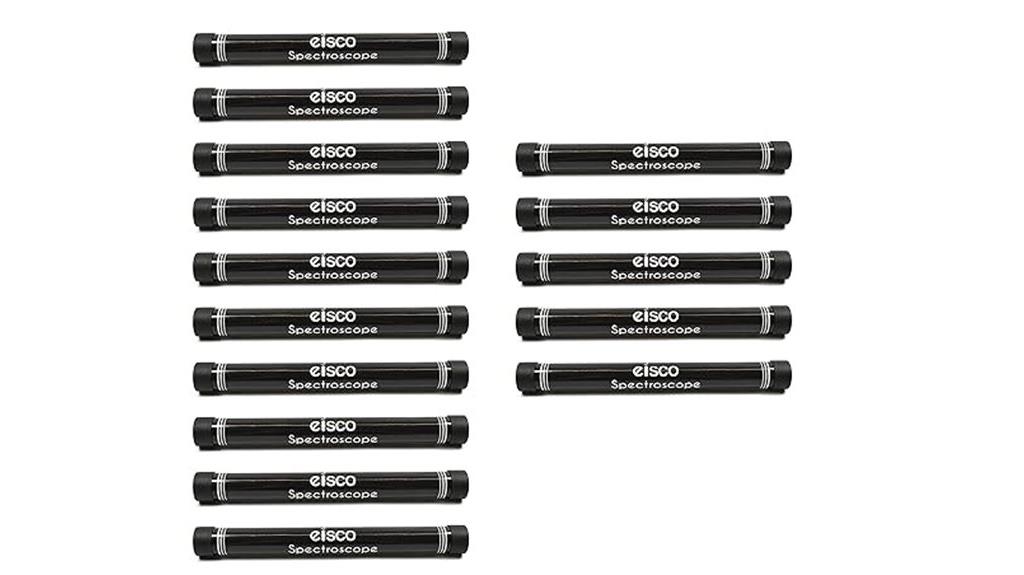
Designed for educators and science enthusiasts alike, the EISCO Economy Spectroscope Tube – 15pk offers an affordable way to explore light spectra in group settings. These lightweight, easy-to-use spectroscopes are perfect for classroom experiments or at-home activities. Each tube allows students to observe spectral lines by holding them up to various light sources, both indoors and outdoors. With a length of just over 10 inches, they’re compact yet effective tools for understanding light emission and spectra. Sold in packs of fifteen, they provide plenty of equipment for demonstrations, group work, or individual exploration, making science both accessible and engaging.
Best For: educators, science students, and science enthusiasts seeking an affordable and straightforward way to explore light spectra in classroom or group settings.
Pros:
- Affordable pack of fifteen spectroscopes ideal for group activities and demonstrations
- Lightweight and easy to operate, suitable for students of all ages
- Enables observation of spectral lines from various light sources for educational purposes
Cons:
- Basic design may lack advanced features found in higher-end spectroscopes
- Limited to viewing light spectra, not suitable for detailed or professional spectroscopy analysis
- Size and build may not withstand rough handling in some environments
TEKCOPLUS Handheld Diffraction Spectroscope for Gemstone Analysis

If you’re a gemologist, hobbyist, or educator seeking a reliable, portable tool for gemstone analysis, the TEKCOPLUS Handheld Diffraction Spectroscope is an excellent choice. Crafted from durable aircraft aluminum, it’s compact, lightweight, and easy to carry anywhere. Its advanced diffraction technology and high-quality grating enable precise analysis of light spectra emitted or absorbed by gemstones and other objects. No batteries are needed, simplifying field use. With clear spectral images and positive user reviews, it’s perfect for quick gemstone identification, light source evaluation, or educational demonstrations. Its rugged design guarantees durability, making it a versatile tool for professionals and amateurs alike.
Best For: gemologists, jewelers, educators, and hobbyists seeking a portable, durable device for gemstone analysis and light spectrum observation.
Pros:
- Compact, lightweight, and portable design for easy field use
- Made from durable aircraft aluminum, ensuring long-lasting performance
- No batteries required, simplifying operation in various environments
Cons:
- Spectral resolution may be modest for highly detailed analysis
- Spectral images can sometimes be dimmer or diffused, affecting clarity
- Slightly smaller size might limit some advanced features found in larger spectroscopes
DSO 138 DIY Oscilloscope Kit with 2.4 TFT Display
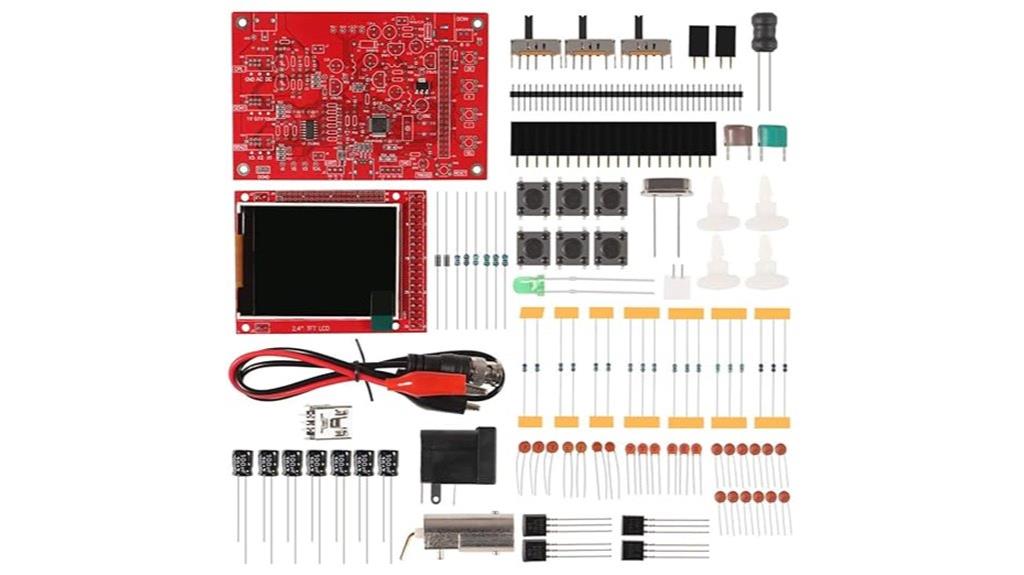
The DSO 138 DIY Oscilloscope Kit with a 2.4-inch TFT display is an excellent choice for electronics enthusiasts and students enthusiastic to learn signal measurement firsthand. Its open-source design, combined with a compact, handheld form, makes it perfect for portable testing. Powered by an ARM Cortex-M3 processor, it offers a 1MSPS sampling rate, allowing effective waveform observation across various applications like audio, video sync, and power supplies. The kit includes all necessary DIY parts and probes, and users can customize it with software as a millivoltmeter or data recorder. It’s ideal for hands-on learning, fostering understanding of oscilloscope principles through practical assembly and experimentation.
Best For: electronics students, DIY enthusiasts, and professionals seeking a portable, customizable oscilloscope for educational and testing purposes.
Pros:
- Open-source design allows for software customization and development.
- Compact, handheld form factor makes it highly portable and convenient for field testing.
- Equipped with a 2.4-inch color TFT display and ARM Cortex-M3 processor for clear visualization and effective signal measurement.
Cons:
- Requires self-assembly, which may be challenging for beginners without prior experience.
- Limited sampling rate of 1MSPS may not suffice for high-frequency signal analysis.
- Basic features might need software upgrades or additional components for advanced testing needs.
S&S Worldwide Educraft Kaleidoscopes Craft Kit (Pack of 25)
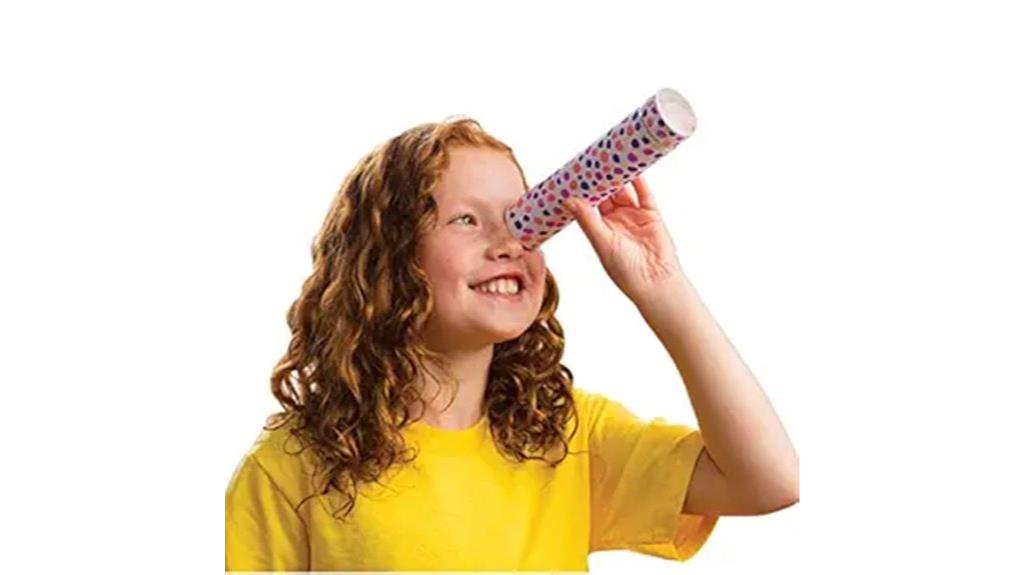
The S&S Worldwide Educraft Kaleidoscopes Craft Kit is perfect for group activities or family projects, as it includes enough supplies to make 25 colorful and creative kaleidoscopes. With two different lengths of cardboard tubes, decorative beads, vinyl circles, tape, and shiny plastic, it offers all the essentials for crafting mesmerizing designs. The kit is safe and easy to assemble, with no glass parts, making it suitable for children aged 8 and up. Plus, the included EduCraft® guide encourages creative decorating with paint or markers, making this kit a fun, educational way to explore light, colors, and patterns together.
Best For: educators, parents, and group leaders seeking a safe, fun, and educational craft activity for children aged 8+ to explore light, colors, and patterns through DIY kaleidoscope making.
Pros:
- Includes enough supplies to create 25 kaleidoscopes, making it ideal for group or family projects.
- Safe design with no glass parts, suitable for children and beginners.
- Encourages creativity with additional decorating options like paint and markers, plus an easy-to-follow guide.
Cons:
- May require additional tools like scissors or markers not included in the kit.
- Limited to the specific materials provided, which might restrict customization for more advanced crafters.
- The kit’s size (6-3/4 inches) may be less suitable for very young children with smaller hands.
Physics Optics Experiment Set, Light Refraction & Reflection Science Kits
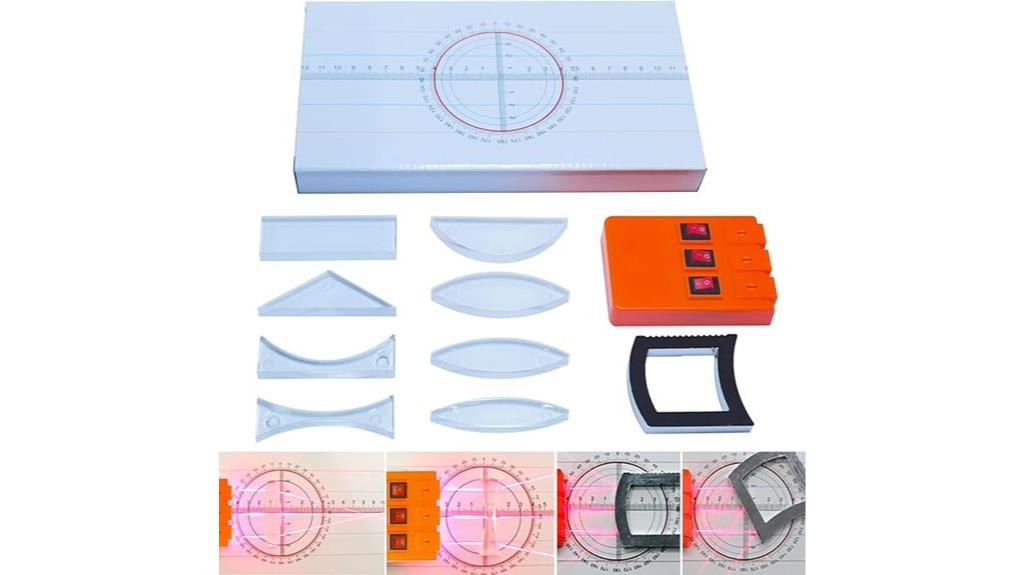
Designed for young science enthusiasts and students, the Physics Optics Experiment Set offers an engaging way to explore light refraction and reflection. It includes simple experiments like plane and diffuse mirror reflection, convex and concave mirror reflection, and refraction through lenses and media. The set helps kids visualize how light changes direction at interfaces, demonstrating phenomena like refraction, reflection, and light propagation. With components like lenses, prisms, and a laser source, students can perform precise experiments to deepen their understanding of optical principles. Its durable materials and clear instructions make learning about physics both fun and accessible.
Best For: young science enthusiasts and students interested in exploring optical physics concepts through hands-on experiments.
Pros:
- Includes comprehensive components like lenses, prisms, and adjustable laser sources for versatile experiments.
- Facilitates clear visualization of refraction and reflection phenomena, enhancing understanding of optical principles.
- Made with durable, high-quality materials and comes with clear instructions for easy setup and use.
Cons:
- Requires manual configuration of the laser source to produce parallel beams, which may be challenging for some users.
- Might need additional accessories or batteries depending on the experimental setup.
- Some users may find the set limited to basic experiments and may seek more advanced optical tools for deeper exploration.
EISCO Economy Spectroscope Tube – 500 Lines/mm Grating – Eisco Labs

If you’re looking for an affordable and straightforward way to explore light spectra, the EISCO Economy Spectroscope Tube with its 500 lines/mm diffraction grating is an excellent choice. Its lightweight design makes it perfect for classroom or home experiments, measuring just over 10 inches long. Simply hold it up to different light sources, and the diffraction grating will split the light into visible spectra, helping you identify wavelengths and learn about spectral emission. With its simple setup and durable construction, this spectroscope offers an engaging, hands-on way to understand the properties of light, making science both accessible and exciting.
Best For: educators, students, and hobbyists seeking an affordable, easy-to-use spectroscope for exploring light spectra in classroom or home settings.
Pros:
- Lightweight and portable design for easy handling and transport
- Simple setup ideal for educational and beginner use
- Durable construction suitable for repeated experiments
Cons:
- Limited to basic spectral observation without advanced features
- May have lower spectral resolution compared to more sophisticated spectrometers
- Customer ratings suggest some users find it less precise or durable than expected
Kbraveo Kaleidoscope Making Kit (3 Sets)

For children aged 5 and up, the Kbraveo Kaleidoscope Making Kit (3 Sets) offers a fun and creative way to explore science and art. The kit includes three paper tubes, mirrors, lenses, and decorative stickers, encouraging kids to personalize their designs. While assembly is simple, it requires peeling films and some trial and error due to missing instructions. The materials can be improved with colorful beads and decorative paper for better visual effects. Despite some mismatched sizes and fragile parts, children enjoy decorating and experimenting with their kaleidoscopes, making it an engaging educational activity that sparks imagination and basic science understanding.
Best For: children aged 5 and up who enjoy hands-on crafting, science exploration, and creative art projects.
Pros:
- Encourages creativity, imagination, and educational development through a fun DIY activity.
- Includes a variety of materials like decorative stickers and paper types to personalize each kaleidoscope.
- Suitable for multiple uses such as gifts, party favors, school projects, and at-home entertainment.
Cons:
- Lacks detailed assembly instructions, requiring online references or trial and error.
- Some components, like mirrors and paper tubes, may be mismatched or shorter than needed.
- Fragile parts such as lens covers and bead caps can crack easily if not handled carefully.
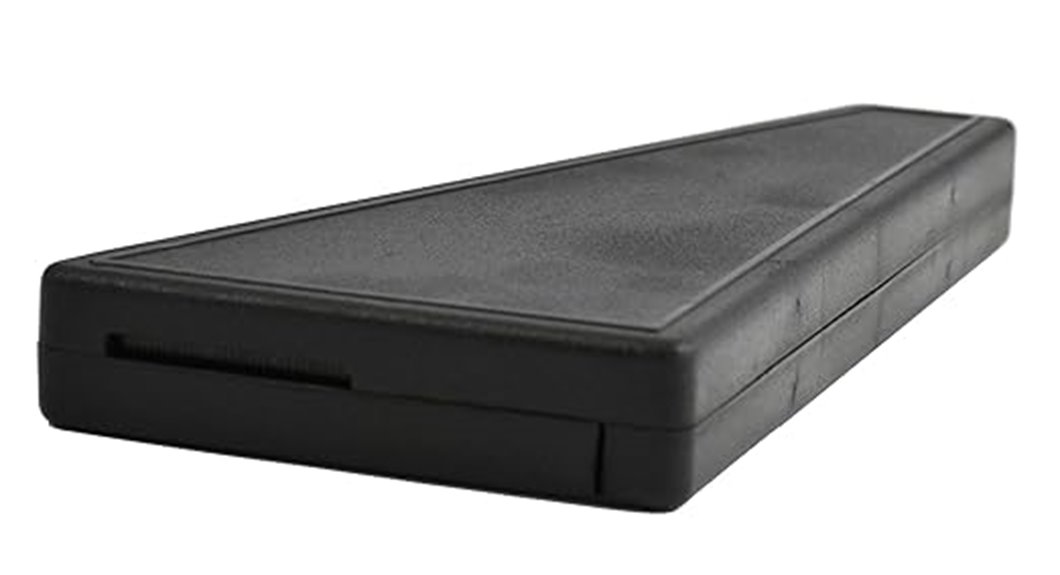
The EISCO Premium Quantitative Spectroscope stands out as an excellent choice for students and educators seeking an affordable yet reliable tool for basic spectral analysis. It covers the 400-700nm range with a ±5nm accuracy, making it suitable for observing emission lines from gas tubes, flames, and LEDs. Its durable construction, adjustable slit, and backlit scale guarantee clearer readings, though its resolution is limited by slit width. Ideal for introductory experiments in physics and chemistry, it allows users to visualize and compare spectra easily. While not suited for detailed scientific research, it offers a practical, educational experience at a budget-friendly price.
Best For: students, educators, and hobbyists seeking an affordable, basic spectroscope for introductory spectral analysis and educational demonstrations.
Pros:
- Affordable and easy to operate, ideal for beginners and classroom use
- Durable construction with adjustable slit and backlit scale for clearer readings
- Suitable for observing broad spectral features from various light sources
Cons:
- Limited spectral resolution due to wide slit width, reducing detail in spectra
- Slight inaccuracies and broad spectral bands may affect precise measurements
- Not suitable for detailed scientific research or high-resolution spectroscopy
Factors to Consider When Choosing DIY Spectroscope Kits for Classrooms
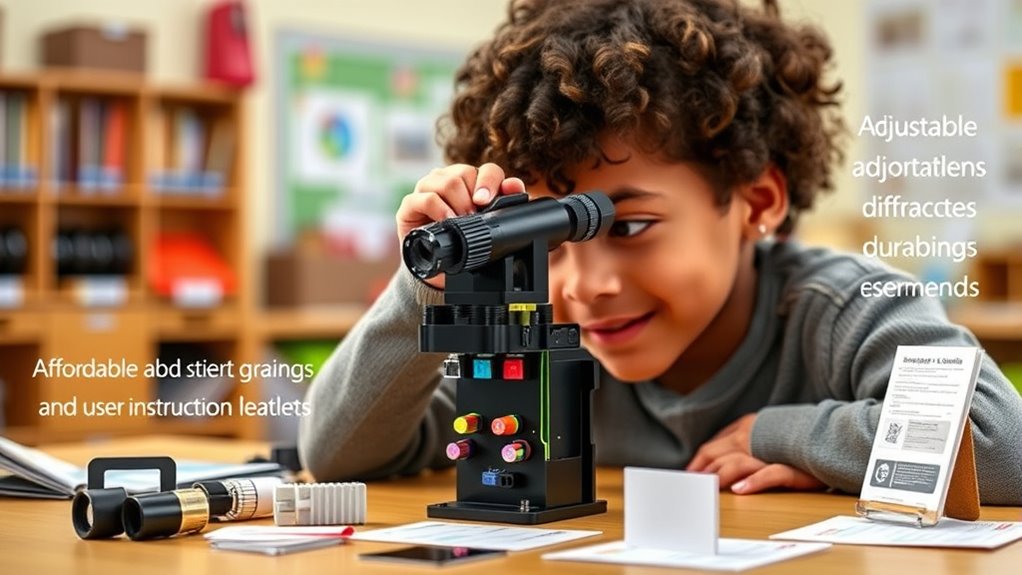
When selecting DIY spectroscope kits for classrooms, I consider factors like material durability and safety to make sure they withstand everyday use and protect students. I also look at accuracy and resolution to get meaningful results, along with how easy the kits are to assemble for quick setup. Finally, I evaluate cost, versatility, and how well the kits can be used across different experiments to maximize value.
Material Durability and Safety
Choosing the right DIY spectroscope kit for classroom use hinges on selecting durable materials that guarantee safety and long-lasting performance. High-quality optical glass and reinforced aluminum bodies are essential because they resist wear, cracking, and peeling, maintaining functionality over time. Using non-toxic, child-safe plastics and coatings reduces health risks and ensures compliance with safety standards. Securely fastened diffraction gratings and sturdy end caps prevent accidental disassembly or damage during handling, ensuring student safety. A lightweight, impact-resistant design minimizes injury risk and makes the kit easier for students to operate confidently. Overall, durable materials not only extend the lifespan of the spectroscope but also provide peace of mind, knowing that safety is prioritized during classroom experiments.
Spectroscope Accuracy and Resolution
Selecting a DIY spectroscope kit for classroom use means considering how accurately it can measure wavelengths and how clearly it can distinguish between nearby spectral lines. Accuracy is often expressed in nanometers (nm), with most kits providing readings within ±5nm to ±10nm. This precision is enough for basic wavelength identification but might fall short for detailed spectral analysis. Resolution, on the other hand, determines how well the spectroscope can separate two close spectral lines. Higher resolution devices use finer diffraction gratings and narrower slits, resulting in clearer separation. Lower-resolution spectroscopes may produce broad bands, making it hard to identify individual lines accurately. Balancing accuracy and resolution is key to selecting a kit suitable for your educational goals, whether for simple experiments or more detailed spectral studies.
Ease of Assembly
Ease of assembly is a crucial factor to contemplate because it directly impacts how quickly and confidently students can build their spectroscopes. Kits with simple designs and fewer parts make the process faster and less frustrating, especially for beginners. Clear, step-by-step instructions or visual guides are essential for helping students understand each stage of assembly. Pre-aligned components or snap-fit parts reduce the need for adjustments, streamlining the experience. Lightweight, portable materials like paper or plastic make handling easier and eliminate the need for special tools. When components fit together securely without glue or extra tools, assembly becomes more intuitive. Overall, a kit crafted for easy assembly encourages student engagement and allows more time for exploration and learning.
Cost and Budgeting
When evaluating DIY spectroscope kits for classroom use, it’s essential to take into account the total cost per unit to guarantee it fits within your budget constraints. Consider not just the initial purchase price but also any additional expenses like replacement parts, accessories, or instructional materials needed for effective use. Cheaper kits may save money upfront but can have durability issues or limited functionality, potentially increasing long-term costs. It’s important to assess whether the kit provides enough quantities for group activities or multiple students without overspending. Prioritize options that are affordable yet meet safety standards and educational requirements. Finding a balance between cost and quality ensures you get a practical, effective tool without straining your budget.
Versatility of Uses
A versatile DIY spectroscope kit can considerably enhance classroom experiments by accommodating a broad range of wavelengths, typically from 400nm to 700nm, which allows for the analysis of various light sources. Supporting this wavelength span ensures students can explore spectra from LEDs, fluorescent lights, flames, and charged gas tubes, broadening learning opportunities. Adjustable components like a rotating slit or focus mechanism enable precise control over spectral patterns, making measurements more accurate and experiments more engaging. Compatibility with different diffraction gratings, such as 500 lines/mm, helps observe detailed spectra across multiple applications. Additionally, an easy-to-assemble design and adaptability for various educational levels make these kits versatile, allowing teachers to tailor activities to different age groups and learning objectives without hassle.
Compatibility With Curriculum
Choosing a DIY spectroscope kit that aligns with your curriculum guarantees that classroom activities support learning objectives effectively. I look for kits that match the educational standards and learning goals, ensuring smooth integration. It’s important to select kits that cover core optics concepts like light decomposition, diffraction, and spectral analysis, reinforcing key topics. I also consider the complexity level, making sure it’s appropriate for my students’ age and skill set, whether elementary or advanced. Clear instructional materials and experiment guides are essential—they help me follow the curriculum’s teaching sequence smoothly. Additionally, I check if features like adjustable slits or diffraction gratings support specific experiments or demonstrations outlined in my curriculum, ensuring the kit enhances my lesson plans.
Frequently Asked Questions
How Durable Are These Spectroscope Kits for Repeated Classroom Use?
These spectroscope kits are quite durable, designed for repeated classroom use. I’ve found that their sturdy construction withstands handling by students and frequent experiments. The materials used resist minor drops and bumps, ensuring longevity. With proper care, they remain functional and reliable over time. I recommend cleaning them gently after use, which helps maintain their durability and performance, making them a great investment for ongoing science lessons.
Are These Kits Suitable for Different Age Groups and Skill Levels?
You’ll find these kits are quite versatile, perfect for a range of ages and skill levels. I’ve used them with both younger students and older ones, and they always engage students effectively. The simple instructions and safe materials make learning fun and accessible, but more advanced features challenge older or more experienced learners. I recommend them for diverse classrooms, as they adapt well and inspire curiosity across the board.
Do the Kits Include Comprehensive Instructions for Easy Assembly and Use?
Yes, these kits include detailed instructions that make assembly and use straightforward. I find the step-by-step guides really helpful, especially for beginners. Clear diagrams and simple language guarantee I can quickly understand how to put everything together and start exploring spectra. It’s designed to be user-friendly, so even if you’re new to science experiments, you’ll feel confident handling the spectroscope and making exciting discoveries right away.
Can These Spectroscopes Analyze Both Light Emission and Absorption Spectra?
Yes, these spectroscopes can analyze both emission and absorption spectra, but it’s not always straightforward. I’ve found that some kits are better suited for emission spectra, showcasing bright lines from light sources. However, with the right setup and a bit of practice, you can also observe absorption spectra, revealing fascinating details about materials and light interactions. It’s a thrilling discovery process that makes science come alive!
Are Replacement Parts or Upgrades Available for Long-Term Classroom Use?
Yes, replacement parts and upgrades are typically obtainable for these spectroscope kits. I recommend checking with the manufacturer’s website or customer service for specific parts like lenses, prisms, or filters. Upgrades can enhance accuracy and durability, making them perfect for long-term classroom use. I’ve found that staying stocked with spare parts ensures your spectroscope remains functional and engaging for students over the years.
Conclusion
In the end, choosing the right DIY spectroscope kit is like finding the needle in the haystack — it’s about matching features to your classroom needs. Whether you want something simple or more advanced, there’s a perfect fit out there. Remember, the right tools can turn science from a challenging task into a walk in the park. So, take your time, weigh your options, and get ready to spark curiosity and excitement!

